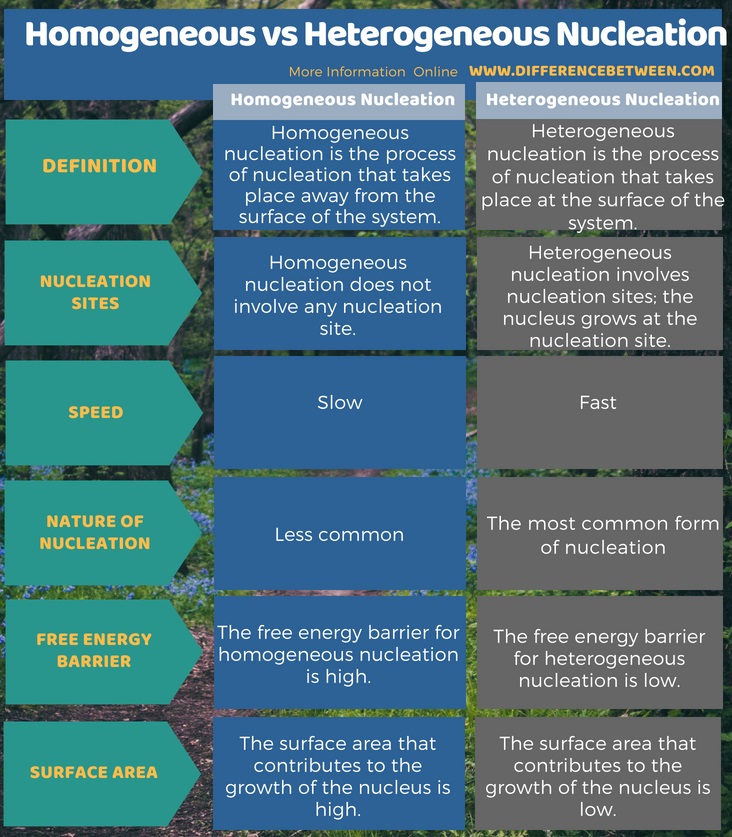Difference Between Homogeneous and Heterogeneous Nucleation
Table of Contents
The key difference between homogeneous and heterogeneous nucleation is that the homogeneous nucleation occurs away from the surface of the system whereas the heterogeneous nucleation occurs at the surface of the system.
Nucleation is the initial step of the process of forming a new thermodynamic phase or a new structure via self-organization. There are two types of it; they are homogeneous nucleation and heterogeneous nucleation. They differ from each other according to the location where the nucleus forms. A nucleation site is a liquid-vapour interface at which a nucleus forms. Therefore, suspension particles, bubbles or the surface of a system can act as a nucleation site. The heterogeneous nucleation occurs at nucleation sites while homogenous nucleation occurs away from a nucleation site.
CONTENTS
1. Overview and Key Difference
2. What is Homogeneous Nucleation
3. What is Heterogeneous Nucleation
4. Side by Side Comparison – Homogeneous vs Heterogeneous Nucleation in Tabular Form
5. Summary
What is Homogeneous Nucleation?
Homogeneous nucleation is the process of nucleation that takes place away from the surface of the system (in which the nucleation occurs). It is a slower process than the heterogeneous type nucleation. Therefore, this is less common.
Usually, the nucleation slows exponentially with the free energy barrier. Further, this energy barrier comes from the free energy penalty of forming the surface of the growing nucleus. Moreover, in the homogeneous nucleation, since this process occurs away from the surface, the nucleus resembles a sphere which has a 4Πr2 surface area. And the growth of the nucleus occurs around the sphere.
What is Heterogeneous Nucleation?
Heterogeneous nucleation is the process of nucleation that takes place at the surface of the system (in which the nucleation occurs). It is faster than the homogeneous type nucleation. Further, this type of nucleation occurs at nucleation sites; an interface between liquid and vapour. Suspended particles, bubbles, the surface of the system can act as a nucleation site. Unlike the homogeneous types of nucleation, this type occurs easily.

Figure 01: Differences in surface area at the surface and away from the surface.
In heterogeneous nucleation, since it occurs at the surface, the free energy barrier for nucleation is low. It is because, at the surface (interface), the surface area of the nucleus that is in contact with surrounding fluid is less (less than the area of a sphere in homogeneous nucleation). Hence, this reduces the free energy barrier and thus, the nucleation process speeds up exponentially.
What is the Difference Between Homogeneous and Heterogeneous Nucleation?
Homogeneous nucleation is the process of nucleation that takes place away from the surface of the system. It does not involve any nucleation site, and it is slow as well. Therefore this form is less common. Moreover, the surface area that contributes to the growth of the nucleus is high in homogeneous nucleation. Heterogeneous nucleation, on the other hand, is the process of nucleation that takes place at the surface of the system. It involves nucleation sites, and it is fast as well. It is thus the most common form of nucleation. Moreover, the surface area that contributes to the growth of the nucleus is low in heterogeneous nucleation. The following infographic presents the difference between homogeneous and heterogeneous nucleation in tabular form.

Summary – Homogeneous vs Heterogeneous Nucleation
Homogeneous and heterogeneous nucleation are the two major forms of nucleation. The difference between homogeneous and heterogeneous nucleation is that homogeneous nucleation occurs away from the surface of the system whereas heterogeneous nucleation occurs at the surface of the system.
Reference:
1. “Nucleation.” Wikipedia, Wikimedia Foundation, 3 July 2018. Available here
2. Wedekind, Jan. “Reguera Research Group.” Introduction to Nucleation. Available here
Image Courtesy:
1.”Surface tension”By MesserWoland – own work created in Inkscape, (CC BY-SA 3.0) via Commons Wikimedia
ncG1vNJzZmivp6x7pbXFn5yrnZ6YsqOx07CcnqZemLyue8OinZ%2Bdopq7pLGMm5ytr5Wau260zqamoJ2emry2v4yapZ1lmJrBpr7OoJynnZ%2BqwG661Jyjnpmknryvew%3D%3D